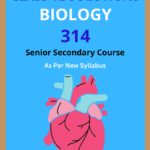NIOS Class 12 Biology Chapter 10 Nitrogen Metabolism Solutions to each chapter is provided in the list so that you can easily browse throughout different chapters NIOS Class 12 Biology Chapter 10 Nitrogen Metabolism Notes and select need one. NIOS Class 12 Biology Chapter 10 Nitrogen Metabolism Question Answers Download PDF. NIOS Study Material of Class 12 Biology Notes Paper 314.
NIOS Class 12 Biology Chapter 10 Nitrogen Metabolism
Also, you can read the NIOS book online in these sections Solutions by Expert Teachers as per National Institute of Open Schooling (NIOS) Book guidelines. These solutions are part of NIOS All Subject Solutions. Here we have given NIOS Class 12 Biology Chapter 10 Nitrogen Metabolism Solutions, NIOS Senior Secondary Course Biology Solutions for All Chapter, You can practice these here.
Nitrogen Metabolism
Chapter: 10
MODULE – II: FORM AND FUNCTION OF PLANTS AND ANIMALS
NIOS TEXTBOOK QUESTIONS ANSWERS
INTEXT QUESTIONS 10.1
1. What is the percent by volume of nitrogen gas in the atmosphere?
Ans: N₂ gas in atmosphere is 78.03%.
2. Name two biomolecules that contain nitrogen in plants.
Ans: (i) Enzymes.
(ii) Proteins.
3. Why nitrogen is a stable molecule?
Ans: Since it is triple (≡) bonded molecule.
4. What is the percentage of nitrogen in protein?
Ans: 16%.
5. What is the boiling point of nitrogen?
Ans: 195.8°C.
6. Choose the correct option: Nitrogen fixation is the conversion of:
(a) atmospheric Nitrogen ⁱⁿᵗᵒ→ Nitrates.
(b) atmospheric Nitrogen ⁱⁿᵗᵒ→ Ammonia.
(c) atmospheric Nitrogenⁱⁿᵗᵒ→ into Amino acids.
Ans: (b) atmospheric Nitrogen ⁱⁿᵗᵒ→ Ammonia.
7. Nitrogen content of biosphere remains constant because of:
(a) Nitrogen cycle.
(b) Nitrogen fixation.
(c) Industrial pollution.
(d) Absorption of nitrogen.
Ans: (a) Nitrogen cycle.
8. Nitrates are converted into nitrogen by microbes called __________.
Ans: Denitrifying Bacteria convert No, into nitrogen.
INTEXT QUESTIONS 10.2
1. Define nitrogen fixation.
Ans: It is defined as “the conversion of molecular nitrogen into NH3.”
2. Which industrial process is utilised for converting nitrogen to ammonia?
Ans: Haber’s Process.
3. Distinguish between biological and abiological nitrogen fixation.
Ans: The biological N₂ fixation takes place in a living cell but a biological N₂ fixation occurs living cell.
4. Name the enzyme that helps in nitrogen fixation in lining cells.
Ans: Nitrogenase enzyme.
5. Which gas prevents nitrogen fixation?
Ans: Oxygen (O₂).
INTEXT QUESTIONS 10.3
1. Match the following:
| Column A | Column B |
| (i) Azotobacter | (a) anaerobic nitrogen fixer. |
| (ii) Clostridium | (b) aerobic nitrogen fixer. |
| (iii) Lichens | (c) nitrogen fixing cyano bacter-ium. |
| (iv) Anabaena | (d) symbiotic nitrogen fixer. |
Ans:
| Column A | Column B |
| (i) Azotobacter | (b) aerobic nitrogen fixer |
| (ii) Clostridium | (a) anaerobic nitrogen fixer. |
| (iii) Lichens | (d) symbiotic nitrogen fixer. |
| (iv) Anabaena | (c) nitrogen fixing cyano bacter-ium. |
2. Which gymnospermous plant fixes nitrogen?
Ans: Cycas plant.
3. Is there any other gas evolved during nitrogen fixation? If yes, name the gas evolved.
Ans: Yes; H₂ (hydrogen gas).
4. How many ATP molecules are required to reduce a single molecule of nitrogen?
Ans: 16 ATP are required.
5. What is the major source of electrons for reduction of nitrogen?
Ans: Reduced coenzymes, e.g. Ferrodoxin.
6. Match the following:
| Column A | Column B |
| (i) Leghemoglobin | (a) Cyanobacterium |
| (ii) Anabaena | (b) Legumes |
| (iii) Reductive process | (c) Nitrogen fixation |
Ans:
| Column A | Column B |
| (i) Leghemoglobin | (b) Legumes |
| (ii) Anabaena | (a) Cyanobacterium |
| (iii) Reductive process | (c) Nitrogen fixation |
7. Name the proteins the help in establishing symbiosis and maintain nodule functioning.
Ans: Nodulins.
INTEXT QUESTIONS 10.4
1. Which is the most reduced form of inorganic nitrogen?
Ans: NH.
2. Match the following:
| Column A | Column B |
| (i) Nitrate reductase | (a) Nitrogen fixation |
| (ii) Nitrite reductase | (b) Nitrate reduction |
| (iii) Nitrogenase | (c) Nitrite reduction |
Ans:
| Column A | Column B |
| (i) Nitrate reductase | (b) Nitrate reduction |
| (ii) Nitrite reductase | (c) Nitrite reduction |
| (iii) Nitrogenase | (a) Nitrogen fixation |
3. In which part of the cell, reduction of nitrate to nitrite occurs?
Ans: Cytol.
4. Which is the most oxidised form of inorganic nitrogen?
Ans: Nitrate.
5. In which plant organelle reduction of nitrite to ammonia is catalysed by the enzyme?
Ans: Chloroplast.
INTEXT QUESTIONS 10.5
1. Match the following:
| Column A | Column B |
| (i) Amino acid | (a) Keto acid |
| (ii) Glutamic acid | (b) Amino group and carboxylic group |
| (iii) a-ketoglutaric acid | (c) Amino acid |
Ans:
| Column A | Column B |
| (i) Amino acid | (b) Amino group and carboxylic group |
| (ii) Glutamic acid | (c) Amino acid |
| (iii) a-ketoglutaric acid | (a) Keto acid |
2. Name two biochemical reactions for biosynthesis of amino acids in plants.
And: (i) Reductive Deamination. and
(ii) Transamination.
3. Which group of enzymes catalyses transamination reaction?
Ans: Transaminases.
4. What is the source of amino group for amino acid synthesis in reductive amination reaction?
Ans. Ammonia (NH₂).
5. Which keto acid is the source for synthesis of glutamic acid?
Ans: Alpha (α) ketoglutaric acid.
TERMINAL EXERCISES
1. Define nitrogen fixation.

Hi! my Name is Parimal Roy. I have completed my Bachelor’s degree in Philosophy (B.A.) from Silapathar General College. Currently, I am working as an HR Manager at Dev Library. It is a website that provides study materials for students from Class 3 to 12, including SCERT and NCERT notes. It also offers resources for BA, B.Com, B.Sc, and Computer Science, along with postgraduate notes. Besides study materials, the website has novels, eBooks, health and finance articles, biographies, quotes, and more.




